 In this newsletter, LiftPort announces that they are creating an “open-source”, wiki-based project to let the Space Elevator community help LiftPort (or someone) “build” a Space Elevator.
In this newsletter, LiftPort announces that they are creating an “open-source”, wiki-based project to let the Space Elevator community help LiftPort (or someone) “build” a Space Elevator.
You can read the newsletter here.

 In this newsletter, LiftPort announces that they are creating an “open-source”, wiki-based project to let the Space Elevator community help LiftPort (or someone) “build” a Space Elevator.
In this newsletter, LiftPort announces that they are creating an “open-source”, wiki-based project to let the Space Elevator community help LiftPort (or someone) “build” a Space Elevator.
You can read the newsletter here.
 Here’s a short piece in The Star Phoenix about how the University of Saskatchewan’s Space Design Team is part of the multimedia innovation Gallery created by the University of Saskatchewan. This team entered the climber which finished first in the first two Space Elevator Games and has to be considered one of the favorites for this year’s competition. A quote from team leader Clayton Ruszkowsky;
Here’s a short piece in The Star Phoenix about how the University of Saskatchewan’s Space Design Team is part of the multimedia innovation Gallery created by the University of Saskatchewan. This team entered the climber which finished first in the first two Space Elevator Games and has to be considered one of the favorites for this year’s competition. A quote from team leader Clayton Ruszkowsky;
“Our research may have a huge impact on society. The space elevator could lead to space tourism, clean energy production, solar system colonization and possibly mining.”
I’m looking forward to their entry this year very much. They were, by far, the most efficient team in last year’s competition and this was using solar power, not a laser. This year I believe the winning climber(s) will be laser-powered and I expected USST to be one of those teams.
 At the Space Elevator Reference, Dr. Brad Edwards announces;
At the Space Elevator Reference, Dr. Brad Edwards announces;
“EuroSpaceward was just awarded funding by The National Research Fund of Luxembourg to hold a workshop on space elevator climber and tether design primarily focusing on systems for entry in the US and German competitions. The tentative dates are Nov. 14-16, 2007 and the workshop will be held in a yet to be announced venue in Luxembourg.”
This is very cool and is yet another sign that the Europeans are getting serious about this idea. Read Dr. Edward’s full post here.
An undated but recent (I think) short article from Softpedia on the Space Elevator…
(Update 29MAY2007 – Comments from both Michael Laine and Brian Dunbar indicate that this is an old article, not a new one. As I’ve written before on other posts, Search Engines are weird things…)
(Update 30MAY2007 – And, yes it is a NEW article. See the comments thread below. My apologies to my search engine 🙂 )
Kristin Ohlson wrote a short piece on the Space Elevator for Entreprenuer.com. You can find it here. She’s also doing a piece for an upcoming issue of the Inflight magazine for US Airways (which I, among others, have been working with her on). When it’s published, I’ll link to it also (assuming it’s available online).
 One note on this Entreprenuer.com article; she writes that this year’s Space Elevator Games will be held in October. Others have written the same thing. Some have written it would be in conjunction with the Space Elevator Games and still others have written that it would be held in Las Vegas.
One note on this Entreprenuer.com article; she writes that this year’s Space Elevator Games will be held in October. Others have written the same thing. Some have written it would be in conjunction with the Space Elevator Games and still others have written that it would be held in Las Vegas.
THIS HAS NOT BEEN FINALIZED YET!!
Ben Shelef of Spaceward.org and Elevator2010.org, the organizer of these games, has been hard at work setting up the venue. But at the moment nothing has been finalized. Anything you read about the when and where of these games at this point is sheer speculation. When an agreement has been reached and signed, you’ll be able to read about it on the Spaceward.org and Elevator2010.org websites, and on this blog.
 At the Space Elevator Reference, Dr. Brad Edwards writes about a proposal he is going to present to the Rutgers Symposium on Lunar Settlements, to be held in New Brunswick, NJ, on June 3-8 (of this year!). Dr. Edwards will be presenting a proposal on how NASA can build and supply a lunar base for about half the cost, and with much greater capacity, than the current NASA program.
At the Space Elevator Reference, Dr. Brad Edwards writes about a proposal he is going to present to the Rutgers Symposium on Lunar Settlements, to be held in New Brunswick, NJ, on June 3-8 (of this year!). Dr. Edwards will be presenting a proposal on how NASA can build and supply a lunar base for about half the cost, and with much greater capacity, than the current NASA program.
The backbone of this proposal will be the development of two, earth-based Space Elevators.
This really and truly rocks. And, reading between the lines here, I’ve got to think that someone, somewhere must be close to announcing a breakthrough in the development of carbon nanotubes of the quality and quantity which are needed. Either that, or else Dr. Edwards believes he can convince NASA that a big check can solve the problem quickly.
Of course, if this happens, and NASA is the lead developer, then it would prove my prediction of a private US consortium (or a joint venture between Dubai and India) as being the first developers of a Space Elevator as being wrong. Gee, I’d sure hate that 🙂
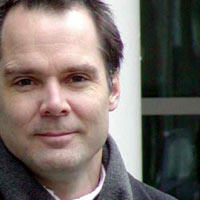 I’d love to go to this symposium, but don’t think I can. From the symposium program, it appears that Dr. Edwards is scheduled to speak from 8:30-9:15am on Thursday, June 7th. Let’s hope Dr. Edwards will make the details of this proposal available soon to all of us. This is the kind of project which the entire space community can and should get behind. Not only would it be beneficial for Lunar colonization, but for Martian colonization as well. And once a Space Elevator (or two) is in place, it changes the entire ballgame regarding space exploration.
I’d love to go to this symposium, but don’t think I can. From the symposium program, it appears that Dr. Edwards is scheduled to speak from 8:30-9:15am on Thursday, June 7th. Let’s hope Dr. Edwards will make the details of this proposal available soon to all of us. This is the kind of project which the entire space community can and should get behind. Not only would it be beneficial for Lunar colonization, but for Martian colonization as well. And once a Space Elevator (or two) is in place, it changes the entire ballgame regarding space exploration.
I say again, this rocks, this well and truly rocks…
(Lunar base drawing courtesy of Ana Benaroya. Click on the thumbnail for a larger version)
At the Space Elevator Reference, they are reporting that during the 5th International Conference on Applied Sciences (to be held sometime in 2008), there will also be a track devoted to “The Space Elevator & Space Engineering & Mathematics Project”. This is intended to;
“Now we will bring together in a special section of the the leaders in the relevant fields, scientists, colleagues and the private industry to push engineering designs of future climbers and allow participants to form partnerships that are beneficial to the teams, industry promoting their products in general.”
Read the full posting here.
 In the same posting, the Space Elevator Reference also discusses the upcoming German Space Elevator Games, also to be held in 2008. It’s not clear from the posting whether or not they will be held in conjunction with the Conference, but looking at the logo, I would guess “yes”. Thanks to a tip from Team Zero G’s Arthur Shay, I reported in early March about these same Games. You can read that post here.
In the same posting, the Space Elevator Reference also discusses the upcoming German Space Elevator Games, also to be held in 2008. It’s not clear from the posting whether or not they will be held in conjunction with the Conference, but looking at the logo, I would guess “yes”. Thanks to a tip from Team Zero G’s Arthur Shay, I reported in early March about these same Games. You can read that post here.
 During the recent SESI 2007 Conference, Brad Edwards announced that a new European organization, EuroSpaceward, would be formed. I blogged about it during the conference (available here).
During the recent SESI 2007 Conference, Brad Edwards announced that a new European organization, EuroSpaceward, would be formed. I blogged about it during the conference (available here).
The Space Elevator Reference is now reporting that this organization will;
The activities being pursued by EuroSpaceward include assisting in the German Space Elevator games to be held in 2008, organizing conferences related to the space elevator with the first one being this November in Luxembourg, publishing several books including The Space Elevator in Spanish and possibly French, and establishing a testing facility in Luxembourg for teams competing in the US or German games.
Read the complete post (here) for the details.
And, by the way, The Space Elevator Reference is now sporting a new look, and showing it’s ties to Space.com.
26MAY07 Update – Oops, I meant SpaceRef.com, not Space. com. Sorry Marc…
 With the addition of returning veterans of the 2006 Space Elevator Games, Snowstar, the teams competing in this year’s Games has increased to twenty-three; two of them competing in the Tether event and twenty-one of them competing in the Climber/Power Beaming event.
With the addition of returning veterans of the 2006 Space Elevator Games, Snowstar, the teams competing in this year’s Games has increased to twenty-three; two of them competing in the Tether event and twenty-one of them competing in the Climber/Power Beaming event.
Of the twenty-one teams competing in the Climber/Power Beaming event, eighteen are in the “main” event, the one where prize money will be handed out, while the other three will be competing in the “Limited” event.
A firm date and venue have not yet been announced, but this should be happening soon. In the meantime, we observers can just peruse the team websites (a list of them is on this blog’s sidebar as well as the Elevator2010 team page) and impatiently wait. If you look, you’ll note that several of the team entries have been removed; the list has been pared down to those who have fully paid their entrance fees. Many of the teams have their own web sites set up and they are great fun to poke around in. You can access their websites from either their link on the sidebar of this blog or from the Elevator2010 team page.
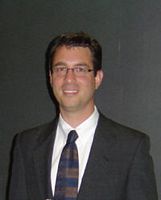 On yesterday’s Space Show, Dr. David Livingston interviewed Liftport’s President & CEO Michael Laine. Michael described, in painful detail, how he and LiftPort arrived at their current situation. There were a number of great quotes from Michael during this show, among them being;
On yesterday’s Space Show, Dr. David Livingston interviewed Liftport’s President & CEO Michael Laine. Michael described, in painful detail, how he and LiftPort arrived at their current situation. There were a number of great quotes from Michael during this show, among them being;
“I’d rather build an elevator to space than cure cancer.”
“I’d rather build an elevator to space than an office building.”
And my favorite; “We can make a fair amount of money off the tethered towers.” The title of this web posting was derived from that quote. Michael was quite clear; LiftPort is now going to concentrate on generating revenue from their Tethered tower product/technology. If they can’t make this work, then they are going to close the doors of LiftPort….
They have a new website devoted to this new focus, www.TetheredTowers.com.
I urge all of those interested in the concept of the Space Elevator to listen to this interview.
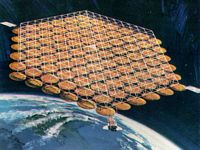 For me, the “killer app” of Space Elevator Development has always been the economically viable deployment of Solar Power Satellites. It promises unlimited, clean energy from the sun, captured by SPS and beamed to earth-based rectennas and from there, channeled into the earth’s power grids. The problem has always been, as I understood it, getting these SPS into orbit cheaply enough so they could be economically viable, and this is still true.
For me, the “killer app” of Space Elevator Development has always been the economically viable deployment of Solar Power Satellites. It promises unlimited, clean energy from the sun, captured by SPS and beamed to earth-based rectennas and from there, channeled into the earth’s power grids. The problem has always been, as I understood it, getting these SPS into orbit cheaply enough so they could be economically viable, and this is still true.
But there’s a BIG difference between making SPS a commercially viable enterprise and making SPS able to generate the lion’s share of earth’s energy usage. In my naiveté, I had hoped they would be one in the same, that we could replace most or all of our polluting energy sources with SPS. Sadly, unless my calculations are way wrong, this turns out to be not the case.
Here’s the basic numbers (I’ll explain where I got them later on in the posting):
I hope my numbers are wrong because they mean that, unless SPS efficiency can be increased by at least an order of magnitude (or two), a SE-SPS solution may be commercially viable, but will not seriously decrease the release of CO2 and other pollutants into our atmosphere.
Another interesting number I came up with is that a space-based solar power array sufficient to power the planet in the year 2030 would be approximately equal in area to the country of India and the rectennas would need to be approximately equal in area to the country of Italy. Well, I thought it was interesting…
I invite everyone to try and prove my numbers wrong – I’ll be very happy if you can show that I’ve overstated the problem somewhere…
Where did I get my numbers?
 I got the SPS performance number from a presentation by Keith Henson. This presentation (PowerPoint format here, pdf format here) is quite interesting. He presents the 2kg/kW number as an aside; his proposal is for a “direct drive” Space Elevator (as opposed to the Edwards-Westling “laser-drive” version). I went to a couple of other sources to try and verify his number. Wikipedia gives a range of .5kg – 10kg per kW. A White paper by the International Union of Radio Science (URSI) gives a number of 1kg/kW for their proposal. So 2kg/kW seemed reasonable to me. Incidentally, I had blogged about his “direct-drive” proposal earlier, here.
I got the SPS performance number from a presentation by Keith Henson. This presentation (PowerPoint format here, pdf format here) is quite interesting. He presents the 2kg/kW number as an aside; his proposal is for a “direct drive” Space Elevator (as opposed to the Edwards-Westling “laser-drive” version). I went to a couple of other sources to try and verify his number. Wikipedia gives a range of .5kg – 10kg per kW. A White paper by the International Union of Radio Science (URSI) gives a number of 1kg/kW for their proposal. So 2kg/kW seemed reasonable to me. Incidentally, I had blogged about his “direct-drive” proposal earlier, here.
The 140T / 125 trips per year number comes directly from the Edwards-Westling book, The Space Elevator.
The projected, yearly, planet-wide energy increase comes from the US Governments Energy Information Administration website. This website contains all sort of fascinating information and I had a lot of fun poking around in it.
This information, in part, led me to the conclusion that only the profit-motive is strong enough to drive the development of the Space Elevator, not the ability to solve our global energy and/or pollution problems. I presented this at the recently completed SESI conference and blogged about it here.
One final note; Keith Henson was recently interviewed by RUSirius. You can find the podcast here. It’s a long podcast; they actually begin talking about at 10:03 into it. I strongly recommend you review Keith’s proposal before you listen to this rather rambling podcast – otherwise it may not make much sense to you.
(The picture is from www.abo.fi – click on it for a larger version)
 As those of you who got up early to try and watch the CBS Sunday Morning Space Elevator segment I blogged about earlier know, or those who TIVO’d it and watched it later know, this segment did not air.
As those of you who got up early to try and watch the CBS Sunday Morning Space Elevator segment I blogged about earlier know, or those who TIVO’d it and watched it later know, this segment did not air.
I emailed the reporter that had contacted me for some material on this story. This is her reply;
“…space elevators got held at the last minute because of time problems…it was meant to be middle part of Bill Geist trilogy about the future…Now I’m told it will air in August, although I’m thinking we may cover the [2007] Competition and do a bigger piece including that.”
So, that’s that – hopefully we’ll see something from them in the future…
![]()
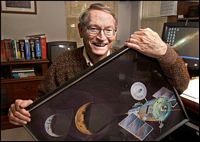 At this year’s ISDC conference, Jerome Pearson, one of the “fathers” of the modern Space Elevator concept, is scheduled to speak on Saturday, May 26th. The title of his presentation is “Space Elevators for Earth & Moon”.
At this year’s ISDC conference, Jerome Pearson, one of the “fathers” of the modern Space Elevator concept, is scheduled to speak on Saturday, May 26th. The title of his presentation is “Space Elevators for Earth & Moon”.
A website detailing some of Mr. Pearson’s accomplishments is here.
(Photo credit; Wade Spees for the Washington Post – click on it for a larger image)
 I received this from Andy Price. That Newton guy was one smart fellow…
I received this from Andy Price. That Newton guy was one smart fellow…
“Jim Dempsey sends along this fabulous quote, which I have to share with you all:
‘I was looking at my old college physics textbook, Alonso-Finn Fundamental University Physics Copyright 1967, I Mechanics, and came across a quote, which when placed in today’s context of Carbon Nanotubes in regards to Van Der Waals force is somewhat spooky. Insight from 300 years ago.’
The Parts of all homogeneal hard Bodies which fully touch one another, stick together very strongly. And for explaining how this may be, some have invented hooked Atoms….
I had rather infer from their Cohesion, that their Particles attract one another by some Force, which in immediate Contact is exceedingly strong, and reaches not far from the Particles with any sensible Effect…. There are therefore Agents in Nature able to make the Particles of Bodies stick together by very strong Attractions. And it is the business of experimental Philosophy to find them out.
Optiks, Book 3, Query 31 (1703), Sir Isaac Newton”
Thanks Andy…
And, from several sources (including reader Eric Jaderlund), I received this related “good news” story about developments in the field of Carbon Nanotubes.
Thanks Eric…
 From the May, 2007 Newsletter;
From the May, 2007 Newsletter;
Michael Laine, President of LiftPort Group, has set a hard date by which we must turn this company profitable. We must produce 25k/month in revenue by September 1st or we will be dissolving the corporation. It’s possible. We have tons of books and other retail items yet to be sold, we have the Tethered Towers balloon product, we have great speakers, we even have a non-working nanotube furnace on the other side of the country that needs a lift. Some of these could produce that revenue on their own; several of them together should be able to do it.
You can read the entire newsletter here.
 The LiftPort Blog pointed me to an interview that Joe Julian (from Liftport) recently gave on the Bob Rivers show. The website for the show is here and a direct link to the interview is here. It appears to be just cut off after about 7 minutes, but, other than the hosts going off-subject into some Lindsay Lohan diet jokes (gotta’ keep all of the audience interested, I guess) along the way, I thought that Joe handled it pretty well.
The LiftPort Blog pointed me to an interview that Joe Julian (from Liftport) recently gave on the Bob Rivers show. The website for the show is here and a direct link to the interview is here. It appears to be just cut off after about 7 minutes, but, other than the hosts going off-subject into some Lindsay Lohan diet jokes (gotta’ keep all of the audience interested, I guess) along the way, I thought that Joe handled it pretty well.
 Michael Laine of Liftport fame (hey, that rhymes!) has posted a plethora of photographs on the flickr website. You can access his “main page” here, and then thumb through the multiple pages of posted photographs.
Michael Laine of Liftport fame (hey, that rhymes!) has posted a plethora of photographs on the flickr website. You can access his “main page” here, and then thumb through the multiple pages of posted photographs.
In the main stream of photographs, many of them are hardware-related, others are “travel photos”, taken, I assume, while they were traveling to-from test sites. There are other streams of pictures; the most interesting, to me, were the ones of the carbon nanotube furnace.
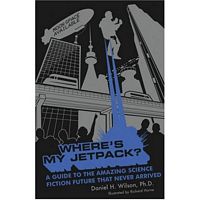 Here is a book review of an effort that sounds interesting and amusing. According to the review, Space Elevators are mentioned in this book, but I have no idea how much or how seriously. Still, if someone is looking for reading material, this may fill the bill. Available at Amazon.com (and probably other places as well)…
Here is a book review of an effort that sounds interesting and amusing. According to the review, Space Elevators are mentioned in this book, but I have no idea how much or how seriously. Still, if someone is looking for reading material, this may fill the bill. Available at Amazon.com (and probably other places as well)…
Another review of the book, complete with an interview with the author, can be found here.
(Click on the thumbnail for a larger version of the Book Cover)
 Google Earth now has a “picture” of a 72km tall building near Bratislava, Slovakia.
Google Earth now has a “picture” of a 72km tall building near Bratislava, Slovakia.
I love Google Earth 🙂
 There is now a YouTube channel comprised solely of videos from the LiftPort crew. These videos show various types of testing they’ve done with their prototypes.
There is now a YouTube channel comprised solely of videos from the LiftPort crew. These videos show various types of testing they’ve done with their prototypes.
There are 8 videos on there now and more are promised in the near future.
I’ve linked to one of the videos here. Visit the channel to view the entire collection…
[youtube]http://www.youtube.com/profile?user=ElevatorToSpace[/youtube]
 This coming Sunday, May 20th, the CBS Sunday Morning show is scheduled to air a segment on the Space Elevator. The reporter researching the show, Mary Lou Teel, has been in touch with several sources (including yours truly), so I’m hopeful that we’ll have a serious, thoughtful treatment of the subject.
This coming Sunday, May 20th, the CBS Sunday Morning show is scheduled to air a segment on the Space Elevator. The reporter researching the show, Mary Lou Teel, has been in touch with several sources (including yours truly), so I’m hopeful that we’ll have a serious, thoughtful treatment of the subject.
You’ll need to check your local listings for what time the show will air in your area. In the Central Time Zone, it is 8:00am.
I’ll have my TIVO running…
In the meantime, here is a story from 2003 that CBS did on the Space Elevator.
 I apologize for the paucity of postings in the past several days; I’ve run into this buzzsaw called FINALS. Fortunately they finished today, so I’m free now for another 2.5 weeks.
I apologize for the paucity of postings in the past several days; I’ve run into this buzzsaw called FINALS. Fortunately they finished today, so I’m free now for another 2.5 weeks.
I’ll pick up the posting pace tomorrow…
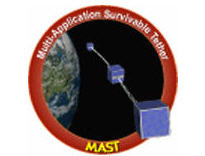 On the MAST blog, they’re reporting that have seen mixed results so far. While they’ve been able to contact “Gadget” and download a lot of data from it, they’ve had only very limited success in actually deploying the tether. From the blog;
On the MAST blog, they’re reporting that have seen mixed results so far. While they’ve been able to contact “Gadget” and download a lot of data from it, they’ve had only very limited success in actually deploying the tether. From the blog;
“Based upon the data we have, we have concluded that Ted did separate from Gadget and begin to deploy the tether. However, a problem with the restraint system prevented Ted from ejecting smoothly, and as a result Ted was pushed away with too little momentum to continue pulling the tether off of the deployer spool. As a result, the deployment halted almost immediately. Our analysis of the magnetometer data we have downloaded from Gadget reveals that the tethered system is rotating slowly, but the length of tether connecting the two bodies is very short. At this point, we believe there is not enough energy in the rotation to pull more tether off of the spool. This is certainly disappointing, as it means that obtaining data on tether survivability may not be possible, but nonetheless we are obtaining interesting data that will be useful in validating models of the behavior of tethered spacecraft.”
This is disappointing, of course, for the Space Elevator community; being able to successfully unspool the Space Elevator ribbon in space will be a necessary requirement for its deployment and it would have been truly wonderful to get some data on how tethers surive in space. Nevertheless, the fact that they were able to successfully launch this experiment and have some success with it should go a long way towards having an even more successful experiment the next time around. Congratulations here are certainly richly deserved…
Read the whole post here.
A nice posting about Space Elevators from A Babe in the Universe. The “prize” for me in this posting is the picture of a model of Space Elevator, labeled as being from last year’s International Space Development Conference.
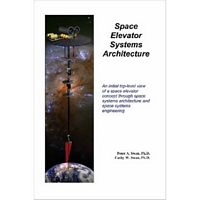 Peter and Cathy Swan have just released a new book which should be of great interest to the Space Elevator community. It’s entitled “Space Elevator Systems Architecture” and should satisfy the “geekiness” in all of us hard-core SE aficiandos…
Peter and Cathy Swan have just released a new book which should be of great interest to the Space Elevator community. It’s entitled “Space Elevator Systems Architecture” and should satisfy the “geekiness” in all of us hard-core SE aficiandos…
A description of the book, from Peter and Cathy;
“Space Elevator Systems Architecture gives a new look at a futuristic SPACE ELEVATOR project from a Systems Architecture perspective. This system of systems is a … “revolutionary way of getting from Earth into space, a ribbon with one end attached to Earth on a floating platform located at the equator and the other end in space beyond geosynchronous orbit. A Space Elevator will ferry satellites, spaceships, and pieces of space stations into space using electric lifts clamped to the ribbon, serving as a means for commerce, scientific advancement, and exploration.” The purpose of this book is to make the Space Elevator’s arena a little easier to understand, through the use of Space Systems Architecture; and, is directed toward decision makers, engineering managers, regulators, financiers, engineers, and technicians. This book lays out the initial “top level” view of a Space Elevator through a Space Systems Architecture approach for space mega-projects in both an academic and a practical manner illustrating steps, tradeoffs, and complexities.”
Once I’ve read this book, I’ll be posting a review of it. Get your copy from Amazon.com today!
(Click on the picture of the book’s cover to see a larger version)
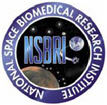 In February, I had blogged about a new microdosimeter being developed by the National Space Biomedical Research Institute. A few days ago, I received their latest newsletter. In it there was a story about how it had been launched in March of this year as part of a multi-experiment payload aboard MidSTAR-1.
In February, I had blogged about a new microdosimeter being developed by the National Space Biomedical Research Institute. A few days ago, I received their latest newsletter. In it there was a story about how it had been launched in March of this year as part of a multi-experiment payload aboard MidSTAR-1.
From their newsletter: “The goal of the MIDN (microdosimeter instrument) project is to develop a rugged, portable, lightweight radiation detection instrument that will measure the three forms of space radiation – solar flares, trapped particle radiation and galactic cosmic rays. When fully developed, the instrument will enable real-time measurement of radiation risk in space and risk of damage to body tissue.”
This device or one similar to it is going to be required, I’m sure, on all Space Elevator payloads, especially human ones, to ensure that the shielding is working properly.
You can go here to read the newsletter with the rest of the story. (Bob Munck alert – it’s a .pdf file)
 About a month ago, stories were circulating that NASA was getting ready to close down NIAC, a decision which many of us found to be incomprehensible. I blogged about this story earlier as did many others.
About a month ago, stories were circulating that NASA was getting ready to close down NIAC, a decision which many of us found to be incomprehensible. I blogged about this story earlier as did many others.
Via Andy Price, I’ve become aware of an effort within NIAC to try and save the agency. They have asked that people who can help them demonstrate benefits of NIAC funding in the past, contact NIAC with this information. Specifically, they are looking for a demonstrated ROI in areas such as;
1) Subsequent investment by NASA, other government agencies, or the private sector.
2) Intellectual contributions that have resulted in an agency putting resources into its own studies of a concept. For example, prompted by the success of a Phase I or Phase II concept, an agency convenes panels to study the work, includes it in a decadal plan, or otherwise funds studies of its own.
3) Unexpected spin-off technologies. For example, some NIAC studies have resulted in new medical technologies.
4) The production of technical PhD and Master’s level students.
5) The production of new jobs.
6) Enhancement of public understanding of agency missions (for most of you, this would be beneficial PR for NASA, or NRO, or DARPA).
For us in the Space Elevator community, the results of NIAC funding have been nothing short of revolutionary; before their funding of Dr. Bradley Edward’s research, an SE was strictly a Science-Fiction concept only. Now it’s something that is an actual possibility. The Space Elevator project is gaining public momentum and acceptance, to the point of being the subject of conferences, in museum exhibits, on TV shows and in Space Elevator games (both for “adults” – ie. chasing after real prize money and for kids, in the Robotic games). To me, this is what “blue-sky” funding is all about; taking a concept which is totally revolutionary and finding a way whereby it can actually happen.
At least that’s something along the lines of what I’m going to say in my letter (email, actually) to NIAC.
Here’s another article about NIAC, this from Wired.com in 2004.
Further words from Brad Edwards on the potential defunding of this program; “My general thoughts are that this is a very poor decision on NASA’s part. NIAC has demonstrated that it can produce results on a small budget unlike other components of NASA proper. Cutting NIAC is easy simply because it is an external contract. NASA would be better served by taking the more difficult road and trimming the non-productive components inside the centers and funding development of new technologies that can save time and money while reducing risk and producing better results in the long-run. NIAC and programs like it, if utilized, can provide the tools to define NASA roadmaps and programs that have low risk and produce the results needed to succeed.”
If you want to offer some words to NIAC, send them to Diana Jennings (djennings [AT] niac.usra.edu). Dr Edwards says to send “Specific results, work, ROI are best but stated support can’t hurt.”
Amen to that. Let’s let ’em know that what they do matters…
 Michael Laine is now trying to build up LiftPort’s presence in cyber-space. He talks about this effort on the LiftPort blog here, here and here. He also wants to recruit others into this effort and is openly appealing for some cyber-help.
Michael Laine is now trying to build up LiftPort’s presence in cyber-space. He talks about this effort on the LiftPort blog here, here and here. He also wants to recruit others into this effort and is openly appealing for some cyber-help.
The NSS Space Elevator Chapter weighs in on Michael’s efforts here.
Michael/LiftPort are obviously between a rock and a hard place. There can be no Space Elevator without qualifying carbon nanotubes and those don’t appear to be imminent (please, please, please, someone announce them tomorrow and prove me wrong). So it’s a question of surviving, in some form or another, until the ribbon material arrives on the scene. And that survival can take the shape of moving into different markets, markets where one can actually sell product (and have a business plan that can attract investors), and/or living in cyber-space, trying to move the project along, until the nanotube logjam is broken.
Michael appears to be doing both, actively looking for applications for his balloon-tether-and-climber, as well as beefing up his cyber-presence. I’ve sent him what thoughts/suggestions I have and I know that many others have too. I hope that something clicks for him soon…
On this blog, and at other places, people have joked about bungee jumping or sky diving from a Space Elevator platform. At Voices/Future Tense, Linus Cohen writes a short piece of fiction of how this might work…